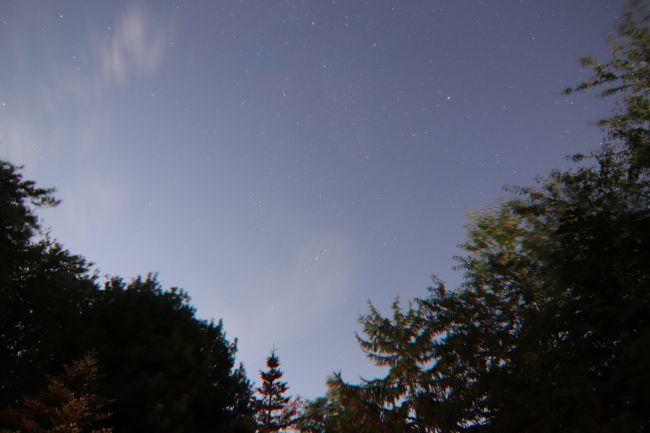Night Sky Images - 19/09/2021
Very clear skies with almost no cloud cover. Got some great images looking back over the house which I've not tried before. Also experimented a little more with various ISO settings with the same composition as well as wider range of exposure times.
Gear:
- Canon EOS 200D
- Tokina AT-X Pro SD 11-16mm f/2.8 (IF) DX
- Tripod
Weather:
- Very clear
Location:
- Garden
Software
- Rawtherapee - RAW file importing, optical correction & image processing
- GIMP - RAW/TIF to JPEG, cropping
Images
These first three images are tests of different exposure lengths, all at the same 800 ISO setting. At 20 seconds the image is relatively clear (though with a relatively modest amount of noise, as expected with a single exposure) with most objects in the centre of the image being well defined and without trails (objects located in the corners will always be slightly elongated on this wide-angle lens):
 Fig. 1: 20s, ISO 800, Processed RAW
Fig. 1: 20s, ISO 800, Processed RAW  Fig. 1: 20s, ISO 800, Unprocessed JPEG
Fig. 1: 20s, ISO 800, Unprocessed JPEG
At 25 seconds a moderate amount of objects are starting to elongate slightly:
 Fig. 1: 25s, ISO 800, Processed RAW
Fig. 1: 25s, ISO 800, Processed RAW  Fig. 1: 25s, ISO 800, Unprocessed JPEG
Fig. 1: 25s, ISO 800, Unprocessed JPEG
At 30 seconds, I start to get very distinct stair trails forming but quite a significant increase in the number of stars:
 Fig. 1: 30s, ISO 800, Processed RAW
Fig. 1: 30s, ISO 800, Processed RAW  Fig. 1: 30s, ISO 800, Unprocessed JPEG
Fig. 1: 30s, ISO 800, Unprocessed JPEG
Looking back in an Easterly direction over our house, showing quite a clear starfield with just a tiny few wisps of cloud:
 Fig. 1: 20s, ISO 1600, Processed RAW
Fig. 1: 20s, ISO 1600, Processed RAW  Fig. 1: 20s, ISO 1600, Unprocessed JPEG
Fig. 1: 20s, ISO 1600, Unprocessed JPEG
Observation: If I want to get more detailed starfield images, then I'm going to have to invest in a star tracker - clearly 25-30 second exposures are just long enough to start forming elongated objects even with my ultra-wide angle Tokina lens. 20 seconds appears to be the sweet spot whilst stationary.